Abstract
1 A single electroconvulsive shock (ECS) of 150 V for 1 s increased the concentration of rat brain 5-hydroxyindoleacetic acid (5-HIAA) but did not alter brain 5-hydroxytryptamine (5-HT) or tryptophan concentrations 3 h later. 2 A single ECS decreased 5-HT synthesis 3 h and 6 h later. Synthesis was back to normal after 24 hours. The ECS-treated rats did not show greater hyperactivity produced by the increased brain 5-HT accumulation following administration of L-tryptophan and tranylcypromine at any time up to 24 h later. This suggests that a single electroshock does not alter 5-HT functional activity. 3 Twenty-four hours after the final ECS of a series of 10 shocks given once daily, the rats were given tranylcypromine and L-tryptophan. They displayed greater hyperactivity than control rats not treated with ECS, suggesting that ECS increases 5-HT functional activity. Brain concentrations of 5-HT, 5-HIAA and tryptophan were then unchanged by ECS. 5-HT synthesis and accumulation of 5-HT following tranylcypromine and L-tryptophan were not altered by ECS. 4 The hyperactivity following administration of the 5-HT agonist 5-methoxy N,N-dimethyltryptamine was enhanced by repeated (10 day) ECS, suggesting altered post-synaptic responses to 5-HT receptor stimulation. 5 Repeated ECS enhanced locomotor activity following tranylcypromine and L-DOPA. It did not alter brain noradrenaline or dopamine concentrations. 6 The latent period before a pentylenetetrazol-induced convulsion was shortened by repeated ECS. 7 Following repeated ECS there appears to be increased neuronal sensitivity to certain stimuli producing centrally mediated behavioural stimulation. This is discussed in relation to the mechanism by which electroconvulsive therapy (ECT) produces its therapeutic effect.
Full text
PDF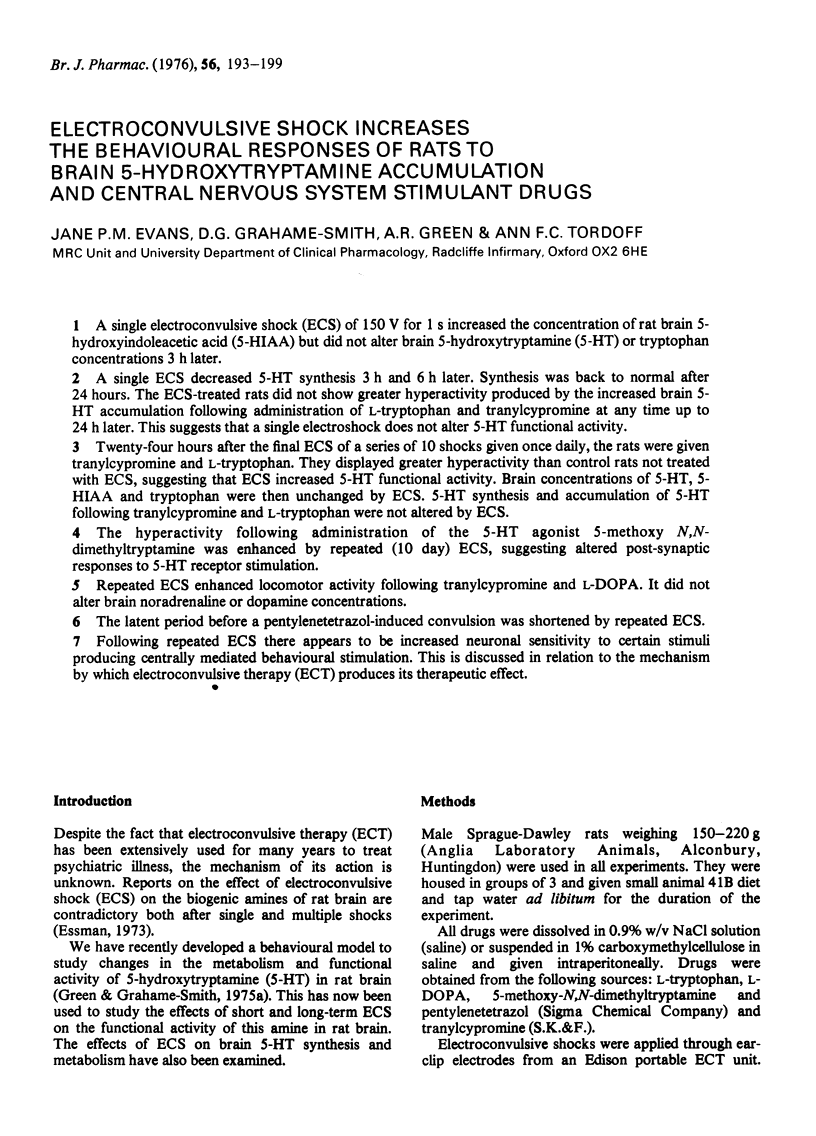
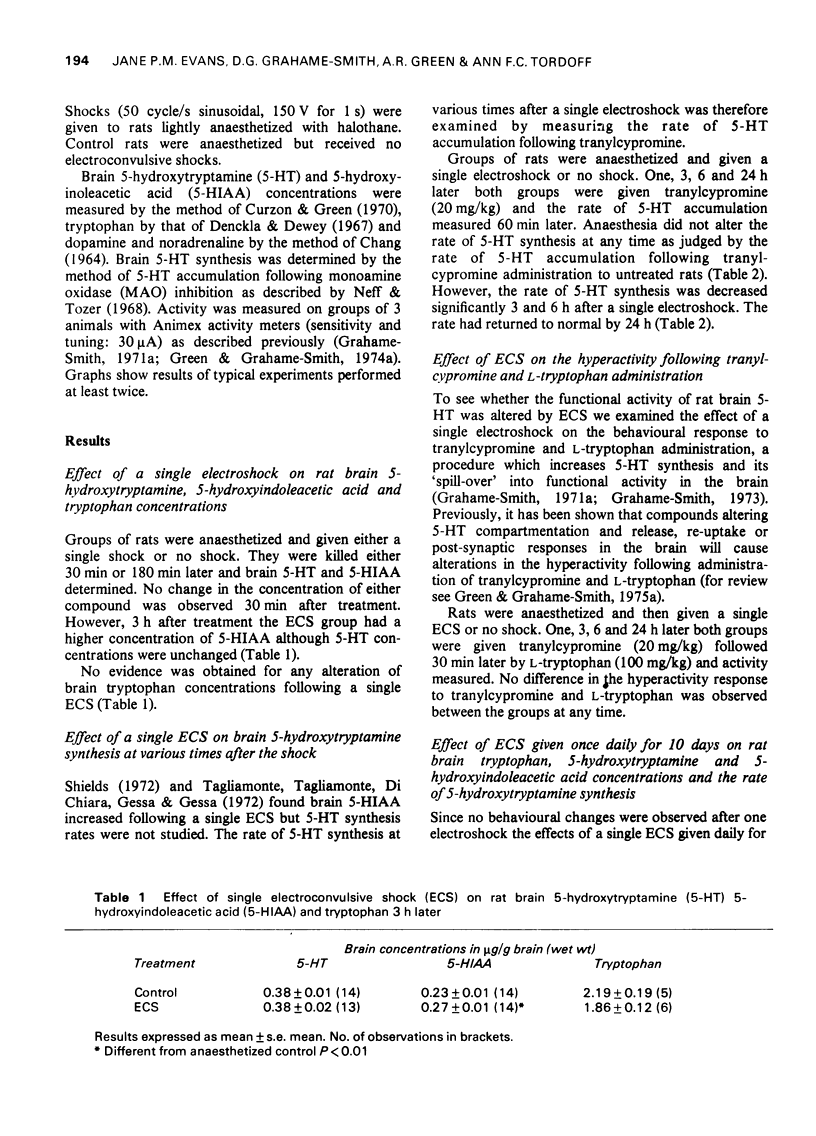

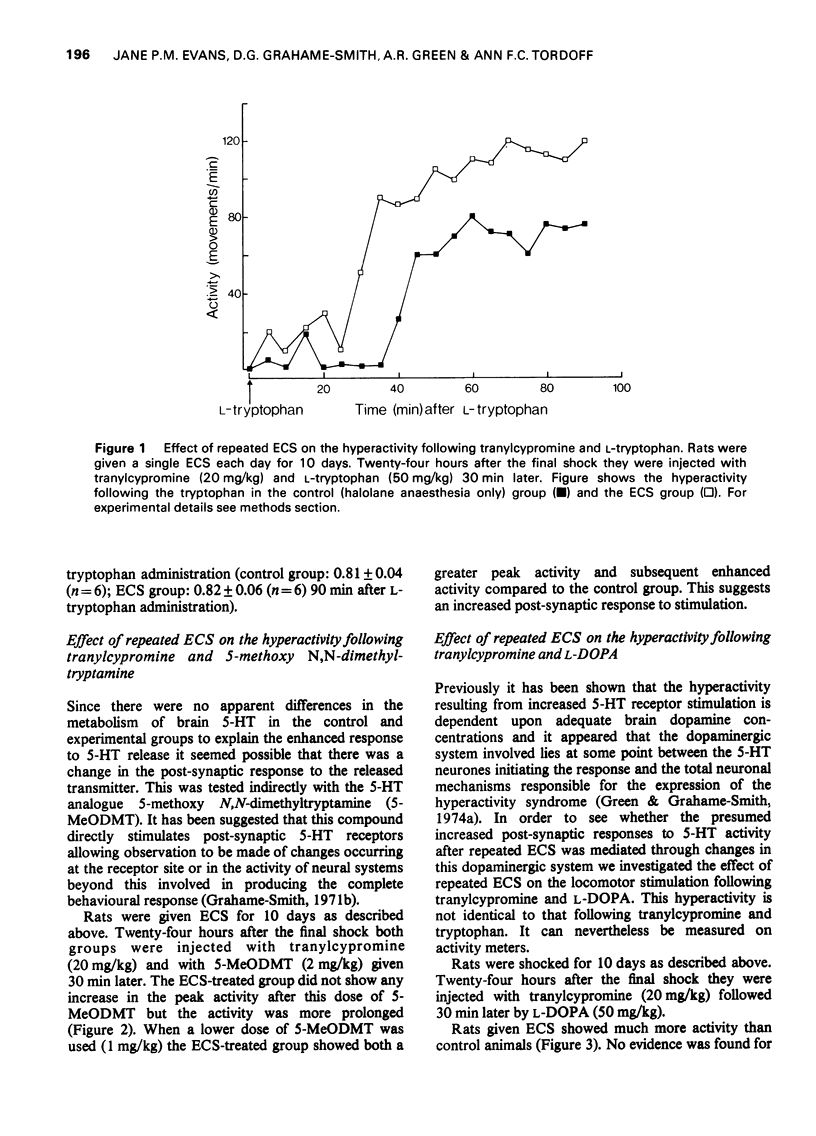
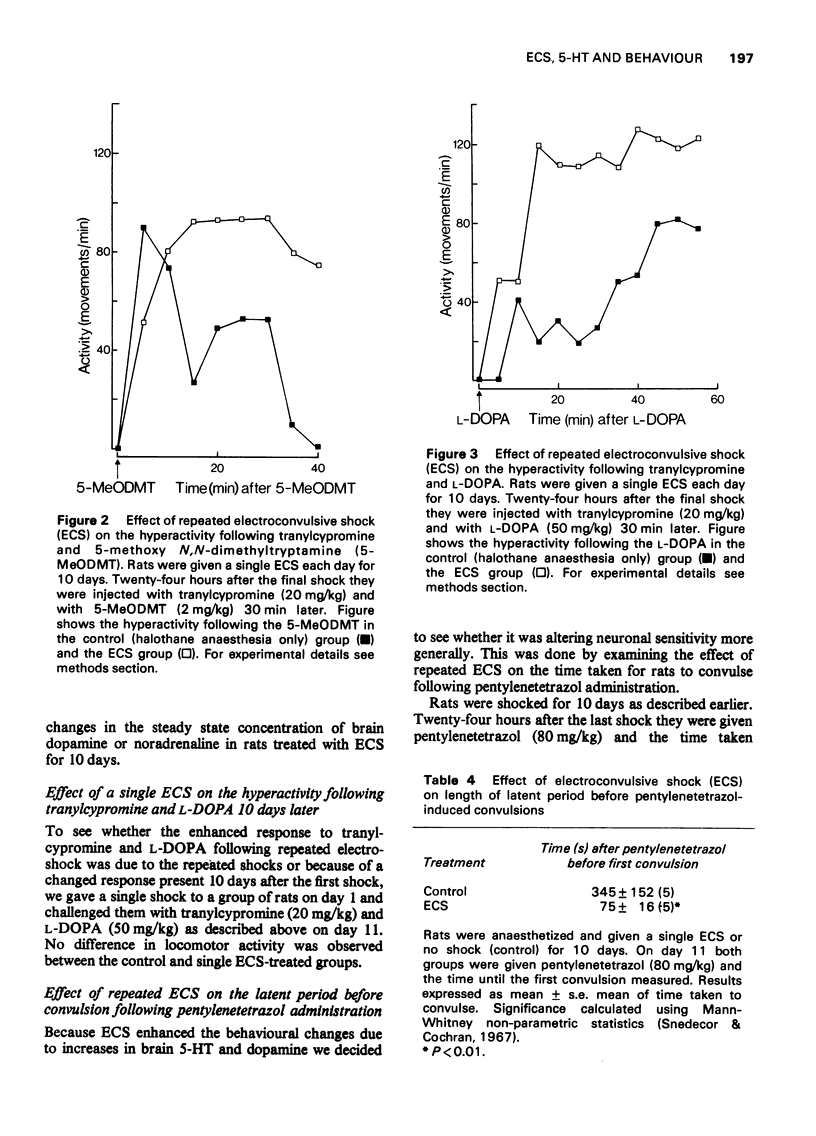
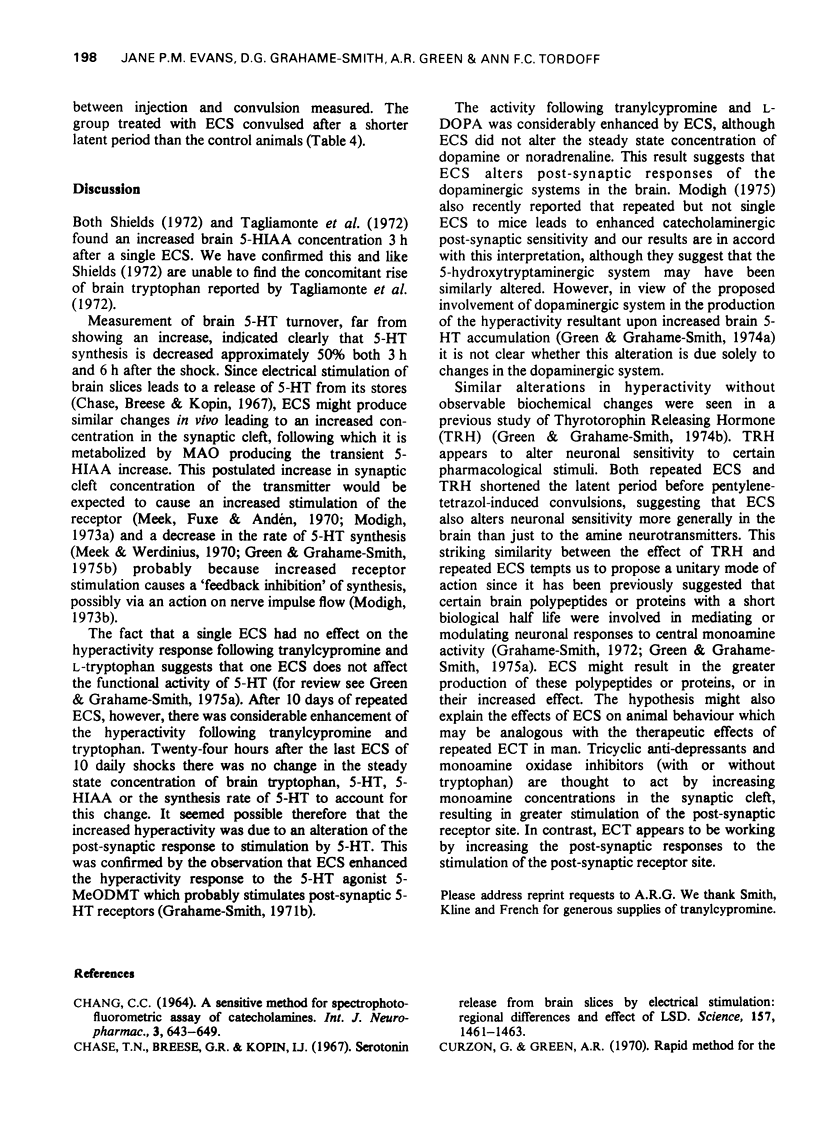

Selected References
These references are in PubMed. This may not be the complete list of references from this article.
- CHANG C. C. A SENSITIVE METHOD FOR SPECTROPHOTOFLUOROMETRIC ASSAY OF CATECHOLAMINES. Int J Neuropharmacol. 1964 Dec;3:643–649. doi: 10.1016/0028-3908(64)90089-9. [DOI] [PubMed] [Google Scholar]
- Chase T. N., Breese G. R., Kopin I. J. Serotonin release from brain slices by electrical stimulation: regional differences and effect of LSD. Science. 1967 Sep 22;157(3795):1461–1463. doi: 10.1126/science.157.3795.1461. [DOI] [PubMed] [Google Scholar]
- Curzon G., Green A. R. Rapid method for the determination of 5-hydroxytryptamine and 5-hydroxyindoleacetic acid in small regions of rat brain. Br J Pharmacol. 1970 Jul;39(3):653–655. doi: 10.1111/j.1476-5381.1970.tb10373.x. [DOI] [PMC free article] [PubMed] [Google Scholar]
- Denckla W. D., Dewey H. K. The determination of tryptophan in plasma, liver, and urine. J Lab Clin Med. 1967 Jan;69(1):160–169. [PubMed] [Google Scholar]
- Grahame-Smith D. G. Studies in vivo on the relationship between brain tryptophan, brain 5-HT synthesis and hyperactivity in rats treated with a monoamine oxidase inhibitor and L-tryptophan. J Neurochem. 1971 Jun;18(6):1053–1066. doi: 10.1111/j.1471-4159.1971.tb12034.x. [DOI] [PubMed] [Google Scholar]
- Grahame-Smith D. G. The prevention by inhibitors of brain proptein synthesis of the hyperactivity and hyperpyrexia produced in rats by monoamine oxidase inhibition and the administration of L-tryptophan or 5-methoxy-N,N-dimethyltryptamine. J Neurochem. 1972 Oct;19(10):2409–2422. doi: 10.1111/j.1471-4159.1972.tb01295.x. [DOI] [PubMed] [Google Scholar]
- Green A. R., Grahame-Smith D. G. The effect of diphenylhydantoin on brain 5-hydroxytryptamine metabolism and function. Neuropharmacology. 1975 Feb;14(2):107–113. doi: 10.1016/0028-3908(75)90033-7. [DOI] [PubMed] [Google Scholar]
- Green A. R., Grahame-Smith D. G. The role of brain dopamine in the hyperactivity syndrome produced by increased 5-hydroxytryptamine synthesis in rats. Neuropharmacology. 1974 Nov;13(10-11):949–959. doi: 10.1016/0028-3908(74)90086-0. [DOI] [PubMed] [Google Scholar]
- Meek J., Fuxe K., Andén N. E. Effects of antidepressant drugs of the imipramine type on central 5-hydroxytryptamine neurotransmission. Eur J Pharmacol. 1970 Mar;9(3):325–332. doi: 10.1016/0014-2999(70)90230-x. [DOI] [PubMed] [Google Scholar]
- Meek J., Werdinus B. Hydroxytryptamine turnover decreased by the antidepressant drug chlorimipramine. J Pharm Pharmacol. 1970 Feb;22(2):141–143. doi: 10.1111/j.2042-7158.1970.tb08412.x. [DOI] [PubMed] [Google Scholar]
- Modigh K. Electroconvulsive shock and postsynaptic catecholamine effects: increased psychomotor stimulant action of apomorphine and clonidine in reserpine pretreated mice by repeated ECS. J Neural Transm. 1975;36(1):19–32. doi: 10.1007/BF01243434. [DOI] [PubMed] [Google Scholar]
- Modigh K. Letter: Effect of chlorimipramine on the rate of tryptophan hydroxylation in the intact and transected spinal cord. J Pharm Pharmacol. 1973 Nov;25(11):926–928. doi: 10.1111/j.2042-7158.1973.tb09981.x. [DOI] [PubMed] [Google Scholar]
- Neff N. H., Tozer T. N. In vivo measurement of brain serotonin turnover. Adv Pharmacol. 1968;6(Pt A):97–109. doi: 10.1016/s1054-3589(08)61160-6. [DOI] [PubMed] [Google Scholar]
- Shields P. J. Effects of electroconvulsive shock on the metabolism of 5-hydroxytryptamine in the rat brain. J Pharm Pharmacol. 1972 Nov;24(11):919–920. doi: 10.1111/j.2042-7158.1972.tb08920.x. [DOI] [PubMed] [Google Scholar]
- Tagliamonte A., Tagliamonte P., Di Chiara G., Gessa R., Gessa G. L. Increase of brain tryptophan by electroconvulsive shock in rats. J Neurochem. 1972 Jun;19(6):1509–1512. doi: 10.1111/j.1471-4159.1972.tb05094.x. [DOI] [PubMed] [Google Scholar]


